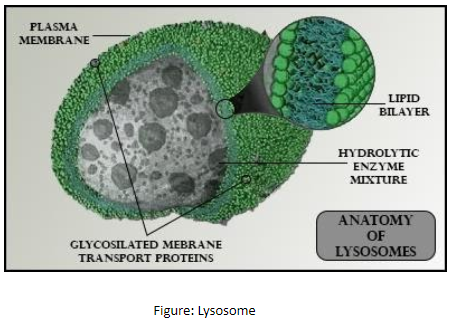
Why are lysosomes also known as scavengers of the cells?
(a)Lysosomes are capable of removing the cell debris having dead and turned cell organelle by digesting them.
(b)Lysosomes are not capable of removing the cell debris having dead and turned cell organelle by digesting them.
(c)Lysosomes are capable of removing the DNA, having died, and turned cell organelle by digesting them.
(d)None of the above
Answer
439.7k+ views
1 likes
Hint: Lysosomes are single membrane-bound cellular organelles that possess many hydrolytic enzymes and this is the reason they are also called the suicide bags of the cell.
Complete answer:
Lysosomes also are known as scavengers of the cells because they are capable of removing the cell debris having dead and non-functioning cell organelle by digesting them. They are in the shape of spheres. The lysosomes have hydrolytic enzymes that can break down almost all kinds of biomolecules such as proteins, nucleic acids, carbohydrates, lipids, and cellular debris.

Additional Information:
-Lysosomes were discovered by the Belgian cytologist Christian René de Duve in the year 1955.
-By convention, the lysosome is the term used for animal cells.
-In the plant cells, the vacuoles do similar functions as the lysosomes.
-The lysosome is found nearly in all types of eukaryotic cells (cells with a clearly defined nucleus).
-Each lysosome is surrounded by a membrane that maintains an acidic environment within the interior via the proton pump.
-Lysosomes originate by budding off from the membrane of the trans-Golgi network, which is a region of the Golgi complex
So, the correct answer is, ’Lysosomes are capable of removing the cell debris having dead and turned cell organelle by digesting them.’
Note: The lysosomes break up larger molecules into smaller molecules. Those smaller molecules can then be used again as a building block for other large molecules. They contain more than 50 different enzymes.
Complete answer:
Lysosomes also are known as scavengers of the cells because they are capable of removing the cell debris having dead and non-functioning cell organelle by digesting them. They are in the shape of spheres. The lysosomes have hydrolytic enzymes that can break down almost all kinds of biomolecules such as proteins, nucleic acids, carbohydrates, lipids, and cellular debris.

Additional Information:
-Lysosomes were discovered by the Belgian cytologist Christian René de Duve in the year 1955.
-By convention, the lysosome is the term used for animal cells.
-In the plant cells, the vacuoles do similar functions as the lysosomes.
-The lysosome is found nearly in all types of eukaryotic cells (cells with a clearly defined nucleus).
-Each lysosome is surrounded by a membrane that maintains an acidic environment within the interior via the proton pump.
-Lysosomes originate by budding off from the membrane of the trans-Golgi network, which is a region of the Golgi complex
So, the correct answer is, ’Lysosomes are capable of removing the cell debris having dead and turned cell organelle by digesting them.’
Note: The lysosomes break up larger molecules into smaller molecules. Those smaller molecules can then be used again as a building block for other large molecules. They contain more than 50 different enzymes.
Latest Vedantu courses for you
Grade 6 | CBSE | SCHOOL | English
Vedantu 6 Pro Course (2025-26)
School Full course for CBSE students
₹45,300 per year
Recently Updated Pages
Master Class 11 Economics: Engaging Questions & Answers for Success

Master Class 11 Business Studies: Engaging Questions & Answers for Success

Master Class 11 Accountancy: Engaging Questions & Answers for Success

Master Class 11 English: Engaging Questions & Answers for Success

Master Class 11 Computer Science: Engaging Questions & Answers for Success

Master Class 11 Maths: Engaging Questions & Answers for Success

Trending doubts
1 ton equals to A 100 kg B 1000 kg C 10 kg D 10000 class 11 physics CBSE

1 Quintal is equal to a 110 kg b 10 kg c 100kg d 1000 class 11 physics CBSE

How much is 23 kg in pounds class 11 chemistry CBSE

Difference between physical and chemical change class 11 chemistry CBSE

Number of oneone functions from A to B where nA 4 and class 11 maths CBSE

What is the z value for a 90 95 and 99 percent confidence class 11 maths CBSE




